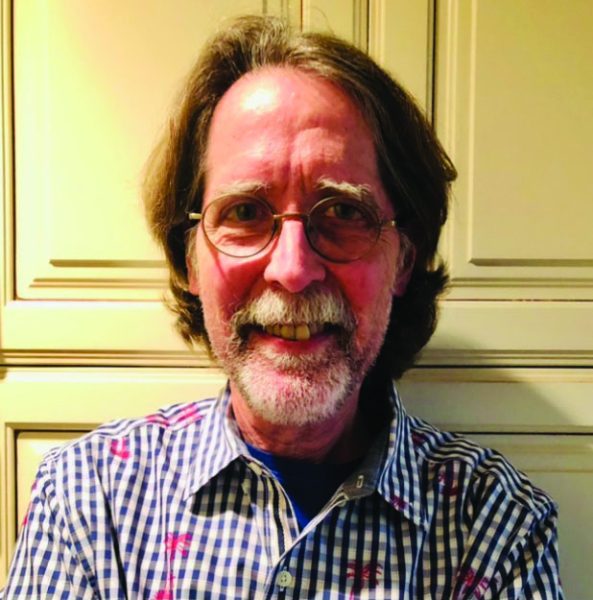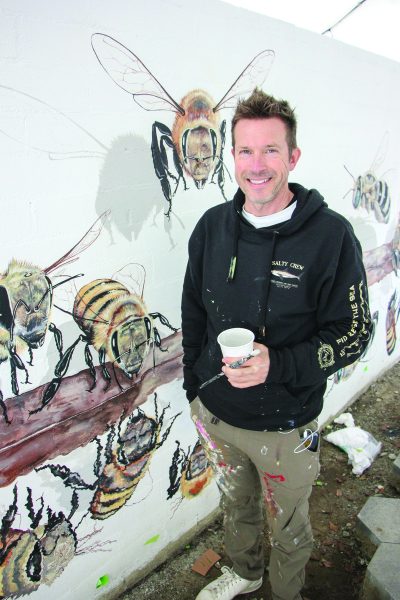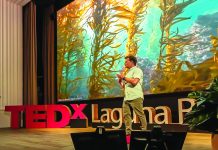A Brush Stroke in a 21-Year Project
 By Gary Stewart
By Gary Stewart
Matthew Willey, who just created a mural at the Water District on 3rd Street, adding to our town’s public art collection, recalls that at age 5, he asked his mother to draw him a horse. (Remember The Little Prince? “Please…Draw me a sheep.”) When she did, he thought, “I want to do that.” He practically got misty-eyed speaking about his admiration for the Old Masters. “Deep down, my heart is with the painters.”
After years of doing mural work for businesses and private homes, he began a long journey from first encountering an ailing bee in his New York City apartment. It grew into an international project to paint murals that will eventually include 50,000 bees, the number in a typical, healthy beehive. I encourage you to search “The Good of the Hive” and check this out. I spent about an hour with Matt, discussing a wide range of issues.

He acknowledges the “youthful adventure quality” of this work, but he terribly misses being able to have a dog. He meets this challenge with a shift in perception, recognizing that in performing service, the idea of sacrifice is altered since it is integral to the work and is, therefore, fulfillment. He speaks of the experience of Siddhartha, who explored the ways to live the best life (wealth, travel, adventure, and asceticism – Matt’s version of which was to paint 35,000 leaves in one room, achieving a meditative state by surrendering to it).
Upon becoming the Buddha, the Enlightened One, Siddhartha found the most fulfilling life was that of the ferryman, transporting people across a river. Matt described informing a visitor of a mural in progress about pollinators and said that maybe they could plant some native flowers, such as “that little movement, back and forth across the river.”
The bees that constitute a beehive are dedicated to cooperative service “for the good of the hive.” The level of thoroughness of cooperation and effectiveness of communication create what is effectively a single organism.
Matt acknowledges that the lessons he had to learn to reach a place where he could support 24 years of being sober also had this element of both service and the false promise of individualism, that you can always heal yourself. “I had to listen to someone else…you cannot and will not survive alone.” This community approach resonates with his understanding of the bees. Matt’s art training always emphasized the individual. When Matt experienced the bees, he came to appreciate how interconnectedness and interdependence define nature. “What I do right here has a ripple effect in Thailand,” and not just metaphorically.
A natural storyteller, Matt describes how every project has a “twist.” The rooftop mural of bees in Nebraska led to conversations with crop-dusters and neighboring farmers, and his discovery that 90% of seeds are owned/patented struck him as nature having been taken hostage. (He is launching a Patreon blog, primarily for such story-telling.)
There are countless ways that the behaviors of bees provide a perspective for considering human behaviors. Bees exhibit “altruistic self-removal from the hive.” A bee that falls ill will voluntarily leave the hive to protect against harming others. Contrast this with the recent measles outbreak in Florida, which did not lead to a large-scale voluntary removal of unvaccinated children from the affected schools “for the good of the hive.” On the contrary, the Surgeon General of Florida encouraged the unvaccinated children it was okay to attend school.
Matt dispels the myth that swarming bees are dangerous. Bees are “at their most docile” when swarming. “Their bellies are full because they’ve got stores because they’re on their way to a new home.” However, they will quickly react defensively if the queen, flying in the center of the swarm, is threatened. Literally, all for one and one for all.
He expressed deep concern for today’s youth. They are facing myriad challenging variables, which can trigger sadness, emptiness, and a lack of purpose. Simultaneously, they have the awareness to support a capacity to understand. He hopes to foster that awareness to show that having fun and creating community is not incompatible with a serious purpose.
In Laguna Beach, “Everyone has been awesome about everything we needed to get this going,” especially the Garden Club. He does somewhat sheepishly admit that the drawing he created to get authorization, which was required well before the work beginning, turned out in the event to be more confrontational, right at eye level, at close range, and he is well aware that many people find bees threatening. But he “started to lean into that” and did not dial it back but softened it using other aspects. He said, “I’m at an inflection point.” He then mused, “This is a brush stroke in a 21-year project, and I am evolving as it’s happening.”
Dr. Stewart, a native of St. Petersburg, Florida, stopped in Nashville and St. Louis for education before arriving in Southern California in 1977. A happily married internal medicine physician with three accomplished children, he is equally enthusiastic about the arts (piano player, art collector, bachelor’s in English, widely read), the sciences (physician, climate activist with Citizens’ Climate Lobby) and fun.




